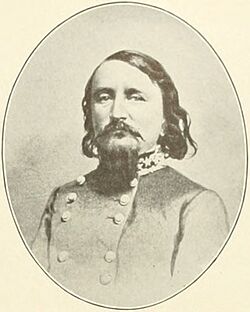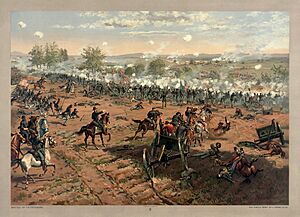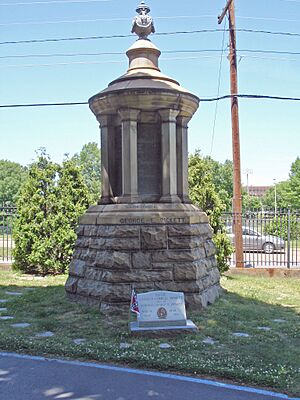George Pickett facts for kids
Quick facts for kids
George Pickett
|
|
|---|---|

Portrait, c. 1860—1875
|
|
| Birth name | George Edward Pickett |
| Born | January 16, 1825 Richmond, Virginia, US |
| Died | July 30, 1875 (aged 50) Norfolk, Virginia, US |
| Buried |
Hollywood Cemetery,
Richmond, Virginia, US |
| Allegiance | |
| Service/ |
|
| Years of service |
|
| Rank |
|
| Commands held | Pickett's Division, First Corps, Army of Northern Virginia |
| Battles/wars | |
| Relations | Henry Heth (cousin) |
| Signature | |
George Edward Pickett (born January 16, 1825 – died July 30, 1875) was an officer in the United States Army. He later became a major general in the Confederate States Army during the American Civil War. He is most famous for leading a major attack called Pickett's Charge. This attack happened on the third day of the Battle of Gettysburg. It was a very difficult and costly battle for the Confederates.
Pickett finished last in his class at the United States Military Academy in 1846. He served as a second lieutenant in the U.S. Army during the Mexican–American War. He was noted for his bravery at the Battle of Chapultepec in September 1847. After this war, he served in the Washington Territory and became a captain. Pickett also took part in the Pig War of 1859.
When the American Civil War began, he joined the Confederate States Army. He became a brigadier general in January 1862. He led a group of soldiers called a brigade during the Peninsula Campaign in 1862. Pickett was hurt at the Battle of Gaines's Mill on June 27.
He returned to lead his soldiers in September 1862. He was given command of a larger group called a division. This division was part of the I Corps under Major General James Longstreet. His division saw little fighting at the Battle of Fredericksburg. They also missed the Battle of Chancellorsville because they were busy with the Suffolk Campaign in 1863.
During the Gettysburg Campaign, Pickett's division was the last to arrive. On July 3, the final day of the battle, his division was one of three that took part in a very risky attack on Union soldiers. This attack is now known as "Pickett's Charge." After the war, Pickett worried about facing legal trouble for some actions during the war. He briefly went to Canada. An old friend, Ulysses S. Grant, helped him, and he returned to Virginia in 1866. He could not rejoin the army. He tried farming and selling insurance. He died at age 50 in July 1875.
Contents
Early Life and Education
George Edward Pickett was born in Richmond, Virginia, on January 16, 1825. He grew up on his family's farm. He was the first of eight children born to Robert and Mary Pickett. His family was well-known in Virginia. He was also a cousin of another future Confederate general, Henry Heth.
When he was 17, Pickett was accepted into the United States Military Academy at West Point. There's a story that Abraham Lincoln helped him get in, but this is probably not true. Lincoln was a state lawmaker and couldn't nominate students. However, Lincoln did give him advice after he was accepted. Pickett was actually nominated by Illinois Congressman John T. Stuart, who was a friend of Pickett's uncle.
Pickett was popular at West Point. He was known for being playful and pulling pranks. He wasn't the best student, but he worked hard enough to graduate. He finished last in his class of 59 students in 1846. This position is sometimes called the "goat." Even though he finished last, Pickett was lucky because a war started right after he graduated. This meant the army needed many new officers.
Serving the United States Army
On July 1, 1846, Pickett became a second lieutenant in the 8th Infantry Regiment. He quickly became known during the Mexican–American War. In September 1847, at the Battle of Chapultepec, he bravely carried the American flag. He was wounded but kept going. His friend, Lieutenant James Longstreet, handed him the flag. Pickett carried it to the top of the palace and raised it, showing that the fortress had surrendered. For his bravery, he was promoted to captain.
In 1849, he was promoted to first lieutenant. In 1855, he became a captain in the 9th Infantry Regiment. In 1851, Pickett married Sally Harrison Minge. She was related to President William Henry Harrison. Sadly, Sally died during childbirth later that year.
Pickett then served in the Washington Territory. In 1856, he helped build Fort Bellingham. He also built a house there, which is still standing today. It's the oldest house in Bellingham. While at Fort Bellingham, Pickett married a Native American woman named Morning Mist. They had a son, James Tilton Pickett (1857–1889). Morning Mist died a few months after their son was born. Their son, "Jimmy" Pickett, later became a newspaper artist.
The Pig War
In 1859, Pickett was sent to San Juan Island. There was a disagreement between American farmers and the British Hudson's Bay Company. This conflict became known as the Pig War. It started when an American farmer shot a pig that belonged to the British company. The British wanted the farmer arrested.
The British sent three warships and 1000 men to the island. The British commander told Pickett and his 68 men to leave. Pickett refused. He told his men, "Don't be afraid of their big guns. We'll make a Bunker Hill of it." Pickett's strong stand prevented a fight. The British had orders to avoid armed conflict if possible. Both sides did not want to go to war over a pig. President James Buchanan sent General Winfield Scott to help settle the dispute peacefully.
Civil War Service
Joining the Confederacy
After the attack on Battle of Fort Sumter in April 1861, Virginia left the Union. Pickett sailed from San Juan Island to resign from the U.S. Army. He then traveled to Richmond, Virginia, to join the Confederate States Army. He became a major in the Confederate Army in March 1861. By January 1862, he was promoted to brigadier general.
Pickett was a very noticeable general. He rode a black horse named "Old Black." He wore a neat uniform with shiny gold buttons and spurs. His mustache was long and curled upwards. His long, perfumed hair was famous in the army.
Pickett's first combat command was during the Peninsula Campaign. He led a brigade of soldiers. He did well in battles like Williamsburg and Seven Pines. At Gaines's Mill on June 27, he was wounded in the shoulder. He kept leading his men for a while, but the wound was serious. He was out of action for three months, and his arm stayed stiff for about a year.
When Pickett returned in September 1862, he was given command of a division. He was promoted to major general on October 10. His division was not heavily involved in the Battle of Fredericksburg in December.
Courtship and Suffolk Campaign
In April 1863, Pickett's division was sent away from General Lee's main army. They were part of the Suffolk Campaign. Because of this, they missed the important Battle of Chancellorsville. The Suffolk Campaign was not a major battle.
Before the Gettysburg Campaign, Pickett fell in love with a young woman named LaSalle "Sallie" Corbell. She was 18 years old. He would travel often from his duties to see her. They married on November 13, 1863. They had two children, George Edward Pickett, Jr. and David Corbell Pickett. David died young from measles.
The Battle of Gettysburg and Pickett's Charge
Pickett's division arrived at the Battle of Gettysburg on the evening of July 2, 1863. They had been delayed guarding supply lines. After two days of hard fighting, General Robert E. Lee's army had not been able to push the Union soldiers off the high ground. Lee planned a huge attack on the center of the Union lines on Cemetery Ridge for July 3.
Lee ordered General Longstreet to lead three divisions in the attack. Pickett's fresh division was one of them. The Union center was held by Major General Winfield Scott Hancock's soldiers. Even though Longstreet was in command, the attack became known as "Pickett's Charge." This was partly because Pickett was the only major general from Virginia in the attack, and Virginia newspapers highlighted his role.
After two hours of artillery fire, the three divisions began to march across open fields. They were almost a mile from Cemetery Ridge. Pickett encouraged his men by shouting, "Up, men, and to your posts! Let no man forget today that you are from Old Virginia." Pickett's division was on the right side of the attack. They faced heavy artillery and musket fire as they moved forward.
One of Pickett's brigades, led by General Armistead, got the farthest into the Union lines. Armistead was badly wounded and died later. This spot is now called the "high-water mark of the Confederacy." The other divisions did not get as far. Armistead's success was not supported, and his men were quickly killed or captured.
The Union army had about 1,500 casualties, but the Confederates had over 6,000. More than half of the men who attacked were killed or wounded. Pickett's division alone lost about 2,800 men out of 5,500. All three of Pickett's brigade commanders and all thirteen of his regimental commanders were killed or wounded.
As soldiers returned to the Confederate lines, Lee tried to rally them. He told them the failure was "all my fault." Pickett was very upset. When Lee told him to gather his division, Pickett reportedly said, "General Lee, I have no division." Pickett's official report about the battle was never found.
Later War Events
After Gettysburg, Pickett commanded soldiers in Southern Virginia and North Carolina. In February 1864, he tried to capture New Bern, North Carolina, from Union forces, but the attack failed. After this battle, Pickett faced controversy regarding his actions involving some captured soldiers. He later fled to Canada to avoid an investigation. However, General Grant helped him, and Pickett returned to the United States in 1866 without facing prosecution.
Pickett's division later helped defend Richmond. They also took part in the Siege of Petersburg.
Battle of Five Forks
General Pickett was ordered by Robert E. Lee to hold the important railroad crossing at Five Forks at all costs. On April 1, at the Battle of Five Forks, Pickett's troops were attacked by Union forces. At the time of the attack, Pickett and other commanders were away from the front lines, enjoying a meal. Union troops quickly overwhelmed Pickett's soldiers. By the time the Confederate commanders realized what was happening, it was too late. This defeat, along with another battle the next day, forced Lee to leave Petersburg. This led to the capture of Richmond and Lee's surrender on April 9.
Appomattox and Surrender
On April 9, Pickett led his remaining soldiers in the Battle of Appomattox Courthouse. He surrendered with Lee's army on April 12, 1865.
There's a story that after the war, Abraham Lincoln visited Pickett's wife, Sallie, in Richmond. The story says Lincoln wanted to check on his old acquaintance. Sallie was surprised and let him hold her baby. However, many historians believe this story is not true.
Life After the War
After the war, Pickett worried about the investigation into his actions in North Carolina. He went to Canada with his wife and son. He stayed there for a year. He returned to the United States in 1866 after hearing that General Ulysses S. Grant had helped end the investigation. Pickett could not rejoin the army. He worked as an insurance agent and a farmer in Norfolk, Virginia.
In 1874, the U.S. Congress officially pardoned George E. Pickett. This happened about a year before he died.
Pickett often felt sad about the many men he lost at Gettysburg. Once, after meeting General Lee, Pickett reportedly complained that Lee "destroyed my division." Another officer, John S. Mosby, supposedly replied, "Yes, but he made you immortal." Most historians think this conversation might not have happened exactly that way. When reporters asked Pickett why Pickett's Charge failed, he often joked, "I've always thought the Yankees had something to do with it."
George E. Pickett died in Norfolk, Virginia, on July 30, 1875. He was 50 years old. He was first buried in Norfolk. Later, his body was moved to Hollywood Cemetery in Richmond, Virginia, on October 24, 1875. More than 40,000 people lined the streets for his funeral. A memorial was built over his grave in 1888.
His wife, LaSalle Corbell Pickett, lived for more than 55 years after him. She died on March 22, 1931. She was eventually buried next to him in Hollywood Cemetery in 1998.
Legacy and Memory
After Pickett's death, his widow, LaSalle, became a well-known writer and speaker. She wrote about "her Soldier" and created an image of Pickett as a perfect Southern gentleman and soldier. She published books about him, including Pickett and His Men (1899). She also published two other books of his letters, but these are now thought to be partly fictionalized by her. Because of this, General Pickett's story is sometimes mixed with the "Lost Cause" idea, which romanticizes the Confederate cause.
Today, Pickett is often seen as a tragic hero. He was a colorful officer who wanted to lead his troops to glory but often missed the chance until the difficult charge at Gettysburg.
A monument to Pickett stands at his grave in Hollywood Cemetery. Another monument to him is in the American Camp on San Juan Island, Washington state.
Fort Barfoot in Blackstone, Virginia, was named in his honor. It was completed in 1942 and was a U.S. Army training facility. It was renamed on March 24, 2023.
In Popular Culture
Actor Stephen Lang played Pickett in the 1993 movie Gettysburg. Billy Campbell played him in the 2003 movie Gods and Generals, which was a prequel. Stephen Lang once said that Pickett had a "sadness" in his eyes.
Pickett also appeared in the 1985 TV mini-series North and South. In the show, he was a cadet at West Point and friends with the main characters.
|




